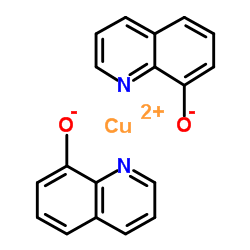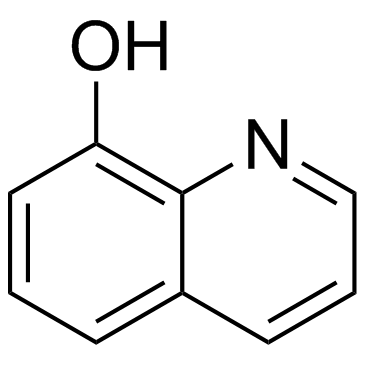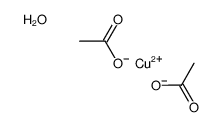Copper quinolate
Modify Date: 2024-01-02 07:29:44

Copper quinolate structure
|
Common Name | Copper quinolate | ||
|---|---|---|---|---|
| CAS Number | 10380-28-6 | Molecular Weight | 351.846 | |
| Density | 1,68 g/cm3 | Boiling Point | 267ºC at 760 mmHg | |
| Molecular Formula | C18H12CuN2O2 | Melting Point | 240 °C (dec.)(lit.) | |
| MSDS | N/A | Flash Point | 143.1ºC | |
| Name | oxine-copper |
|---|---|
| Synonym | More Synonyms |
| Density | 1,68 g/cm3 |
|---|---|
| Boiling Point | 267ºC at 760 mmHg |
| Melting Point | 240 °C (dec.)(lit.) |
| Molecular Formula | C18H12CuN2O2 |
| Molecular Weight | 351.846 |
| Flash Point | 143.1ºC |
| Exact Mass | 351.019470 |
| PSA | 44.24000 |
| LogP | 4.15330 |
|
Section 1. Chemical Product and Company Identification 8-Hydroxyquinoline, Copper Salt Common Name/ Trade Name Manufacturer Commercial Name(s) Synonym
Chemical Name Chemical Family 8-Hydroxyquinoline, Copper Salt Section 4. First Aid Measures Eye ContactCheck for and remove any contact lenses. In case of contact, immediately flush eyes with plenty of water for at least 15 minutes. Get medical attention. Skin ContactIn case of contact, immediately flush skin with plenty of water. Cover the irritated skin with an emollient. Remove contaminated clothing and shoes. Wash clothing before reuse. Thoroughly clean shoes before reuse. Get medical attention. Serious Skin ContactWash with a disinfectant soap and cover the contaminated skin with an anti-bacterial cream. Seek medical attention. InhalationIf inhaled, remove to fresh air. If not breathing, give artificial respiration. If breathing is difficult, give oxygen. Get medical attention. Serious InhalationNot available. IngestionDo NOT induce vomiting unless directed to do so by medical personnel. Never give anything by mouth to an unconscious person. Loosen tight clothing such as a collar, tie, belt or waistband. Get medical attention if symptoms appear. Serious IngestionNot available. Section 5. Fire and Explosion Data Flammability of the Product May be combustible at high temperature. Auto-Ignition Temperature Not available. Flash PointsNot available. Flammable LimitsNot available. Products of CombustionThese products are carbon oxides (CO, CO2), nitrogen oxides (NO, NO2...). Fire Hazards in Presence of Slightly flammable to flammable in presence of heat. Various Substances Explosion Hazards in Presence Risks of explosion of the product in presence of mechanical impact: Not available. of Various SubstancesRisks of explosion of the product in presence of static discharge: Not available. Fire Fighting MediaSMALL FIRE: Use DRY chemical powder. and InstructionsLARGE FIRE: Use water spray, fog or foam. Do not use water jet. Special Remarks onNot available. Fire Hazards Special Remarks on Explosion Not available. Hazards Section 6. Accidental Release Measures Small SpillUse appropriate tools to put the spilled solid in a convenient waste disposal container. Finish cleaning by spreading water on the contaminated surface and dispose of according to local and regional authority requirements. Large SpillUse a shovel to put the material into a convenient waste disposal container. Finish cleaning by spreading water on the contaminated surface and allow to evacuate through the sanitary system. 8-Hydroxyquinoline, Copper Salt Section 7. Handling and Storage PrecautionsKeep away from heat. Keep away from sources of ignition. Ground all equipment containing material. Do not ingest. Do not breathe dust. Wear suitable protective clothing. In case of insufficient ventilation, wear suitable respiratory equipment. If ingested, seek medical advice immediately and show the container or the label. Avoid contact with skin and eyes. StorageKeep container tightly closed. Keep container in a cool, well-ventilated area. Do not store above 8°C (46.4°F). Refrigerate. Section 8. Exposure Controls/Personal Protection Engineering ControlsUse process enclosures, local exhaust ventilation, or other engineering controls to keep airborne levels below recommended exposure limits. If user operations generate dust, fume or mist, use ventilation to keep exposure to airborne contaminants below the exposure limit. Personal ProtectionSplash goggles. Lab coat. Dust respirator. Be sure to use an approved/certified respirator or equivalent. Gloves. Personal Protection in Case of Splash goggles. Full suit. Dust respirator. Boots. Gloves. A self contained breathing apparatus should be used a Large Spillto avoid inhalation of the product. Suggested protective clothing might not be sufficient; consult a specialist BEFORE handling this product. Exposure LimitsNot available. Section 9. Physical and Chemical Properties Physical state and appearance Solid. (crystalline powder)OdorNot available. Not available. Taste Molecular Weight351.85 g/mole greenish-yellow Color Not applicable. pH (1% soln/water) Boiling PointNot available. Melting Point>200°C (392°F) Critical TemperatureNot available. Specific GravityNot available. Not applicable. Vapor Pressure Vapor DensityNot available. Not available. Volatility Odor ThresholdNot available. Water/Oil Dist. Coeff.Not available. Ionicity (in Water)Not available. Dispersion PropertiesNot available. SolubilityInsoluble in cold water, hot water. Section 10. Stability and Reactivity Data StabilityThe product is stable. Instability TemperatureNot available. Conditions of InstabilityExcess heat, excess dust generation Incompatibility with variousNot available. substances CorrosivityNot available. 8-Hydroxyquinoline, Copper Salt Special Remarks onNot available. Reactivity Special Remarks onNot available. Corrosivity PolymerizationWill not occur. Section 11. Toxicological Information Routes of EntryInhalation. Ingestion. Toxicity to AnimalsAcute oral toxicity (LD50): 3940 mg/kg [Mouse]. Acute dermal toxicity (LD50): >2000 mg/kg [Rabbit]. Chronic Effects on Humans MUTAGENIC EFFECTS: Mutagenic for bacteria and/or yeast. Other Toxic Effects onHazardous in case of inhalation. HumansSlightly hazardous in case of skin contact (irritant, permeator), of ingestion. Special Remarks onLethal Dose/Conc 50% Kill: Toxicity to AnimalsLC50 [Rat] - Route: Inhalation; Dose: 820 mg/kg. *Please Note that the time period for testing was not indicated by the Registery of Toxic Effects of Chemial Substances (RTECS). Special Remarks onMay affect genetic material and may cause cancer based on animal data. No human data found. Chronic Effects on Humans Special Remarks on otherAcute Potential Health Effects: Toxic Effects on HumansSkin: May cause skin irritation. It may be absorbed through the skin. Eye: Dust may cause eye irritation. Inhalation: Dust may cause respiratory tract irritation. May be harmful if inhaled. Ingestion: May affect behavior (somnolence - general depressed activity), gastrointestinal tract (irritation, diarrhea, hypermotility), repiratory system (dyspnea), nervous system Chronic Potential Health Effects: liver (hepatitis), urinary system, spleen, metabolism (weight loss), blood. Section 12. Ecological Information EcotoxicityNot available. BOD5 and CODNot available. Possibly hazardous short term degradation products are not likely. However, long term degradation products may Products of Biodegradation arise. The products of degradation are less toxic than the product itself. Toxicity of the Products of Biodegradation Special Remarks on theNot available. Products of Biodegradation Section 13. Disposal Considerations Waste DisposalWaste must be disposed of in accordance with federal, state and local environmental control regulations. 8-Hydroxyquinoline, Copper Salt Section 14. Transport Information DOT ClassificationNot a DOT controlled material (United States). IdentificationNot applicable. Not applicable. Special Provisions for Transport DOT (Pictograms) Section 15. Other Regulatory Information and Pictograms TSCA 8(b) inventory: 8-Hydroxyquinoline, Copper Salt Federal and State Regulations CaliforniaCalifornia prop. 65: This product contains the following ingredients for which the State of California has found to cause cancer which would require a warning under the statute: No products were found. Proposition 65 Warnings California prop. 65: This product contains the following ingredients for which the State of California has found to cause birth defects which would require a warning under the statute: No products were found. Other RegulationsEINECS: This product is on the European Inventory of Existing Commercial Chemical Substances (EINECS No. 233-841-9). Canada: Listed on Canadian Non-Domestic Substance List (NDSL). China: Listed on National Inventory. Japan: Listed on National Inventory (ENCS). Korea: Listed on National Inventory (KECI). Philippines: Listed on National Inventory (PICCS). Australia: Listed on AICS. WHMIS (Canada) CLASS D-1B: Material causing immediate and serious toxic effects (TOXIC). Other Classifications DSCL (EEC) R20- Harmful by inhalation.S22- Do not breathe dust. Health Hazard HMIS (U.S.A.)2 National Fire Protection 1 Flammability 1 Association (U.S.A.) Fire Hazard 2 0 Reactivity Health Reactivity 0 Specific hazard Personal Protection E WHMIS (Canada) (Pictograms) DSCL (Europe) (Pictograms) TDG (Canada) (Pictograms) 8-Hydroxyquinoline, Copper Salt ADR (Europe) (Pictograms) Protective Equipment Gloves. Lab coat. Dust respirator. Be sure to use an approved/certified respirator or equivalent. SECTION 16 - ADDITIONAL INFORMATION N/A |
CHEMICAL IDENTIFICATION
HEALTH HAZARD DATAACUTE TOXICITY DATA
MUTATION DATA
|
|
~82% 
Copper quinolate CAS#:10380-28-6 |
| Literature: Journal of Solid State Chemistry, , vol. 106, p. 451 - 460 |
|
~% 
Copper quinolate CAS#:10380-28-6 |
| Literature: Kinetics and Catalysis, , vol. 26, p. 50 - 57 Kinetika i Kataliz, , vol. 26, p. 61 - 68 |
|
~28% 
Copper quinolate CAS#:10380-28-6 |
| Literature: Russian Journal of Physical Chemistry, , vol. 54, # 12 p. 1784 - 1786 Zhurnal Fizicheskoi Khimii, , vol. 54, p. 3118 - 3122 |
|
~% 
Copper quinolate CAS#:10380-28-6 |
| Literature: Helvetica Chimica Acta, , vol. 8, p. 596 - 602 |
| Precursor 3 | |
|---|---|
| DownStream 0 | |
| HS Code | 2933499090 |
|---|---|
| Summary | 2933499090. other compounds containing in the structure a quinoline or isoquinoline ring-system (whether or not hydrogenated), not further fused. VAT:17.0%. Tax rebate rate:13.0%. . MFN tariff:6.5%. General tariff:20.0% |
| cupric 8-quinolinoxide |
| QUINONDO |
| Copper(2+) di(8-quinolinolate) |
| 8-Hydroxyquinoline copper complex |
| copper 8-quinolinolate |
| Copper 8-hydroxyquinolinate |
| Dokirin |
| 8-Hydroxyquinoline Copper Salt |
| MFCD00067392 |
| Oxine-Copper |
| Copper quinolate |
| Dokivin |
| 8-Quinolinol, copper(2+) salt (2:1) |
| Milmer 1 |
| Culinate |
| Copper-8 |
| (8-hydroxy quinolinato)2Cu |
| Fruitdo |
| bis(quinolin-8-olato-O,N)copper(II) |
| Cunilate |
| Copper(II) Bis(8-hydroxyquinolinate) |
| [Cu(8-HQ)2] |
| Copper(2+) diquinolin-8-olate |
| Copper-8-hydroxyquinoline |
| bis(8-hydroxyquinolato)copper(II) |
| Cupric 8-quinolinolate |
| copper(II) bis(quinolin-8-olate) |
| Bis(8-quinolinolato)copper(II) |
| Milmer |
| bis(8-quinolinolato-κN1,κO8)copper |
| EINECS 233-841-9 |
| bis(8-hydroxyquinolinato)copper(II) |
| bioquin1 |
| Copper-8-quinolinolate |
| oxine-Cu |






